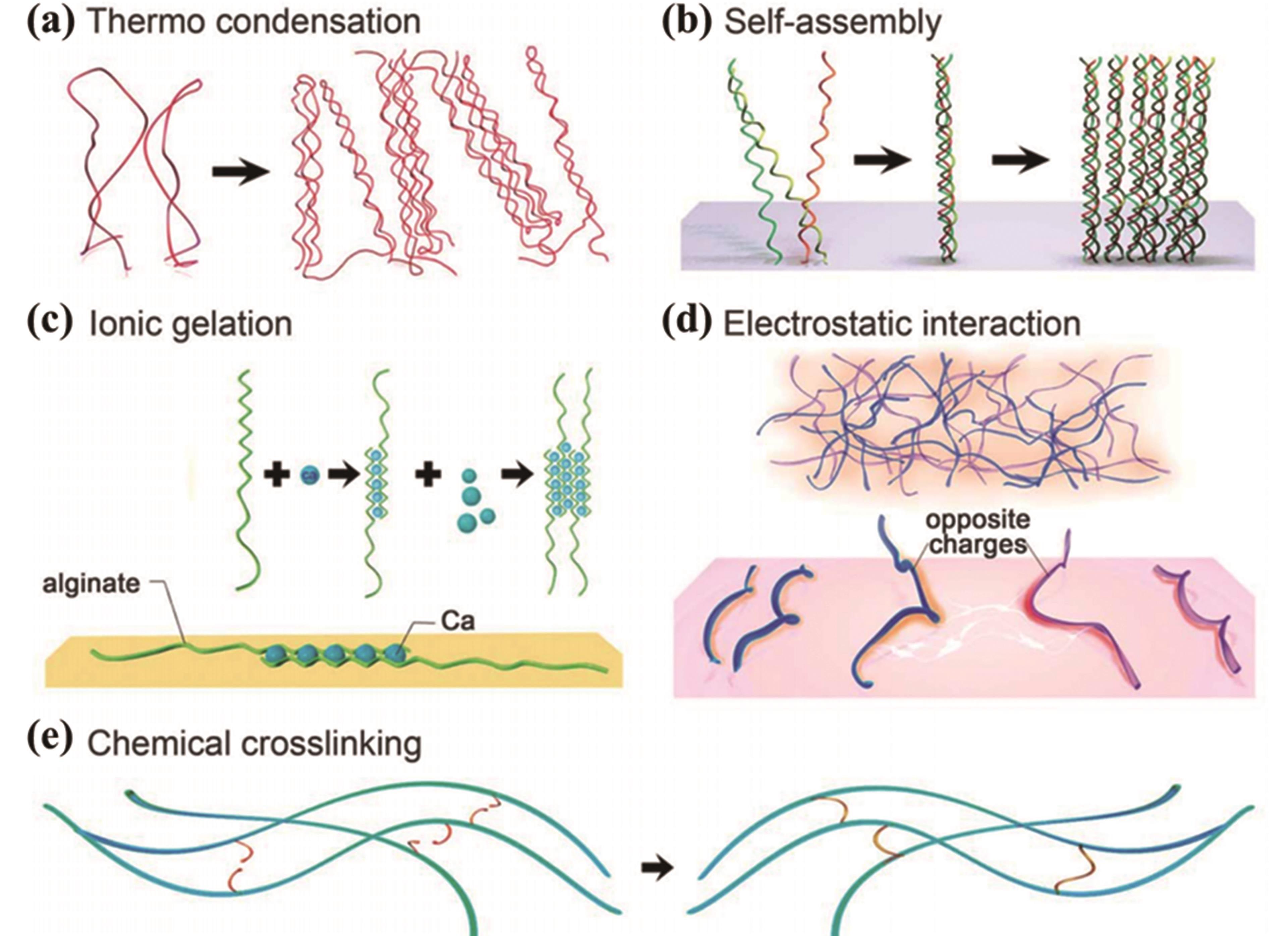
应用化学 ›› 2022, Vol. 39 ›› Issue (1): 35-54.DOI: 10.19894/j.issn.1000-0518.210488
水凝胶的制备及仿生设计在能源领域应用的研究进展
刘旭1, 李杨可欣1, 杜黎1, 于健2, 王佳程1, 耿阳1, 韩广2, 孙宽1, 李猛1( )
)
- 1.重庆大学能源与动力工程学院,低品位能源利用技术及系统教育部重点实验室,CQU?NUS新能源材料与器件联合实验室,重庆 400044
2.重庆大学材料与科学工程学院,重庆 400044
-
收稿日期:2021-09-30接受日期:2021-11-04出版日期:2022-01-01发布日期:2022-01-10 -
通讯作者:李猛 -
基金资助:国家自然科学基金(52173235);重庆市自然科学基金(cstc2018jcyjAX0375)
Bio⁃inspired Hydrogels: Synthesis, Bionic Design and Applications in the Field of Energy Storage and Conversion
LIU Xu1,LI Yang-Ke-Xin1,DU Li1,YU Jian2,WANG Jia-Cheng1,GENG Yang1,HAN Guang2,SUN Kuan1,LI Meng1( )
)
- 1.CQU-NUS Renewable Energy Materials & Devices Joint Laboratory,MOE Key Laboratory of Low-Grade Energy Utilization Technologies and Systems,School of Energy & Power Engineering,Chongqing University,Chongqing 400044,China
2.School of Materials Science and Engineering,Chongqing University,Chongqing 400044,China
-
Received:2021-09-30Accepted:2021-11-04Published:2022-01-01Online:2022-01-10 -
Contact:Meng LI -
About author:limeng@cqu.edu.cn
-
Supported by:the National Natural Science Foundation of China(51702032);the Natural Science Foundation of Chongqing(cstc2018jcyjAX0375)
摘要:
能源与环境问题是当前时代面临的一大课题,有效利用并储存能源,缓解一系列严峻的环境污染问题也是当前研究的热点,电化学储能、光催化、光热界面蒸发和水汽收集这些能源利用措施已经作为环保手段深入人类的生活。大自然作为一位天然的设计师为我们能够提供诸多灵感,自然界诸多生物、生命体系中特性、机制和结构均暗含着十分巧妙的奥秘。本文重点介绍了水凝胶在上述能源转换技术的应用。首先简单介绍了水凝胶这种新型高分子材料的特性、分类、合成等信息。然后,对电化学储能、光催化、光热界面蒸发等能源领域的先进技术及相应要求进行了简要介绍。电化学储能需要足够多的反应活性位点保证高效的能量转换,水凝胶比表面积大的特点能够为电化学储能提供更多反应位点,并且其良好的柔性和机械性能可以使能源转换装置适应更多应用环境。光催化、光热界面蒸发均需要优异的光吸收性能,且通过将热量集中于蒸发表面和调节蒸发水状态两种手段均能够有效增强光热界面蒸发性能。水凝胶具有多孔性,能够增强光强的多次反射,使光线被重复吸收,从而增强光吸收性能。合理选择含水化功能官能团的聚合物也能够调整水的状态,因而水凝胶的聚合物链对水的状态有着一定影响,通过调节水的状态降低水的蒸发焓,也能够提高光热蒸发性能。结合向大自然学习的仿生思想,仿生水凝胶已经经历了由简单的利用生物质成分,到结构仿生,再到目前的生物灵感启发型仿生3个过程,文章通过列举仿生水凝胶在能源和环境领域应用的具体实例,说明了将仿生和水凝胶相结合的前景及优势,为后续研究提供了新思路。最后,对仿生水凝胶今后的发展进行了总结和展望。
中图分类号:
引用本文
刘旭, 李杨可欣, 杜黎, 于健, 王佳程, 耿阳, 韩广, 孙宽, 李猛. 水凝胶的制备及仿生设计在能源领域应用的研究进展[J]. 应用化学, 2022, 39(1): 35-54.
LIU Xu, LI Yang-Ke-Xin, DU Li, YU Jian, WANG Jia-Cheng, GENG Yang, HAN Guang, SUN Kuan, LI Meng. Bio⁃inspired Hydrogels: Synthesis, Bionic Design and Applications in the Field of Energy Storage and Conversion[J]. Chinese Journal of Applied Chemistry, 2022, 39(1): 35-54.
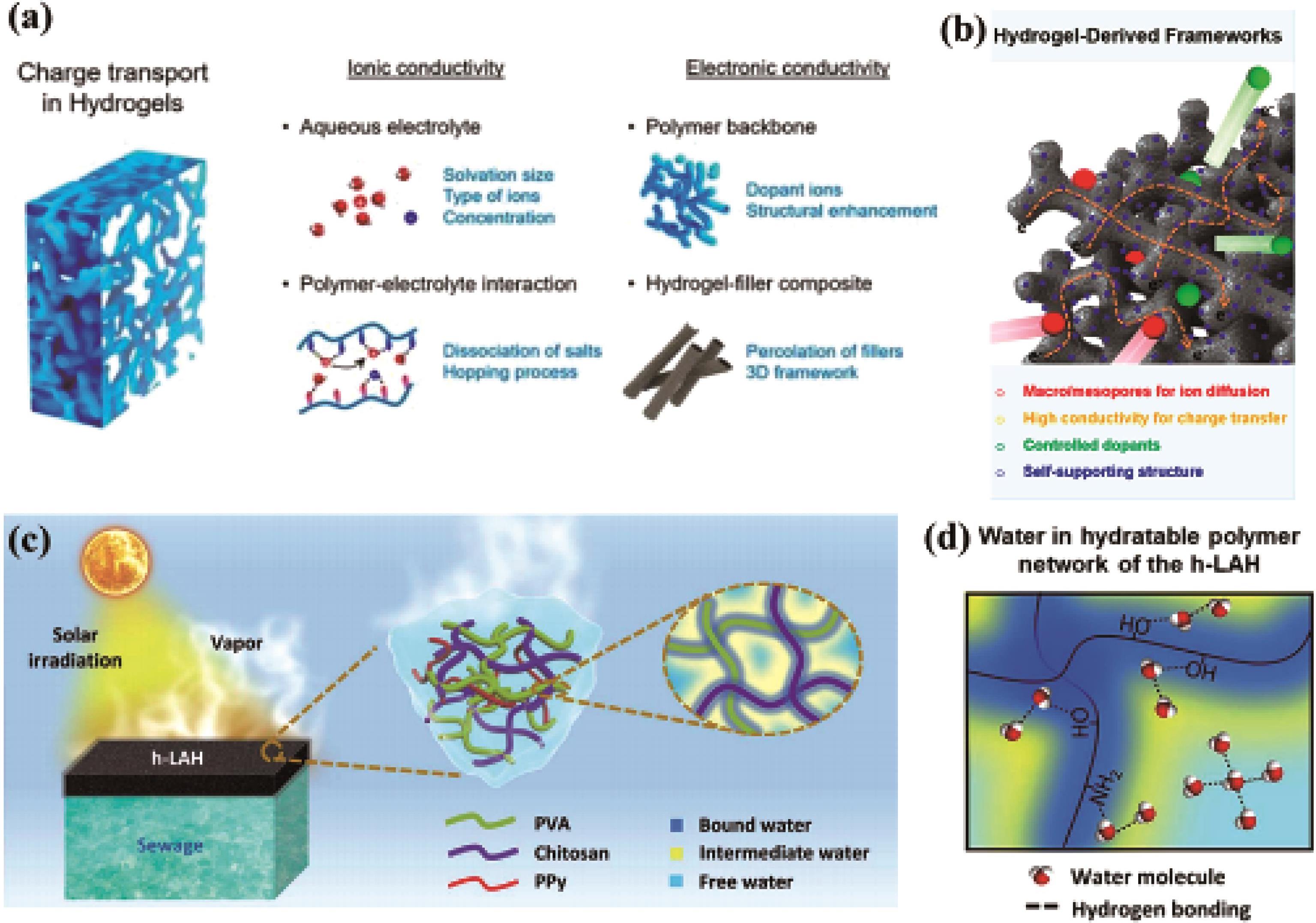
图1 水凝胶在能源领域应用的优势: (a)水凝胶中的导电机制[17];(b)水凝胶衍生的骨架特征[17];(c - d)水凝胶用于调控网络内部水的状态[25]
Fig.1 Applications of hydrogels :(a) Conduction mechanism in hydrogels[17]; (b) Characterization of hydrogel-derived framework[17]; (c - d) Tuning water states in the network of hydrogel[25]
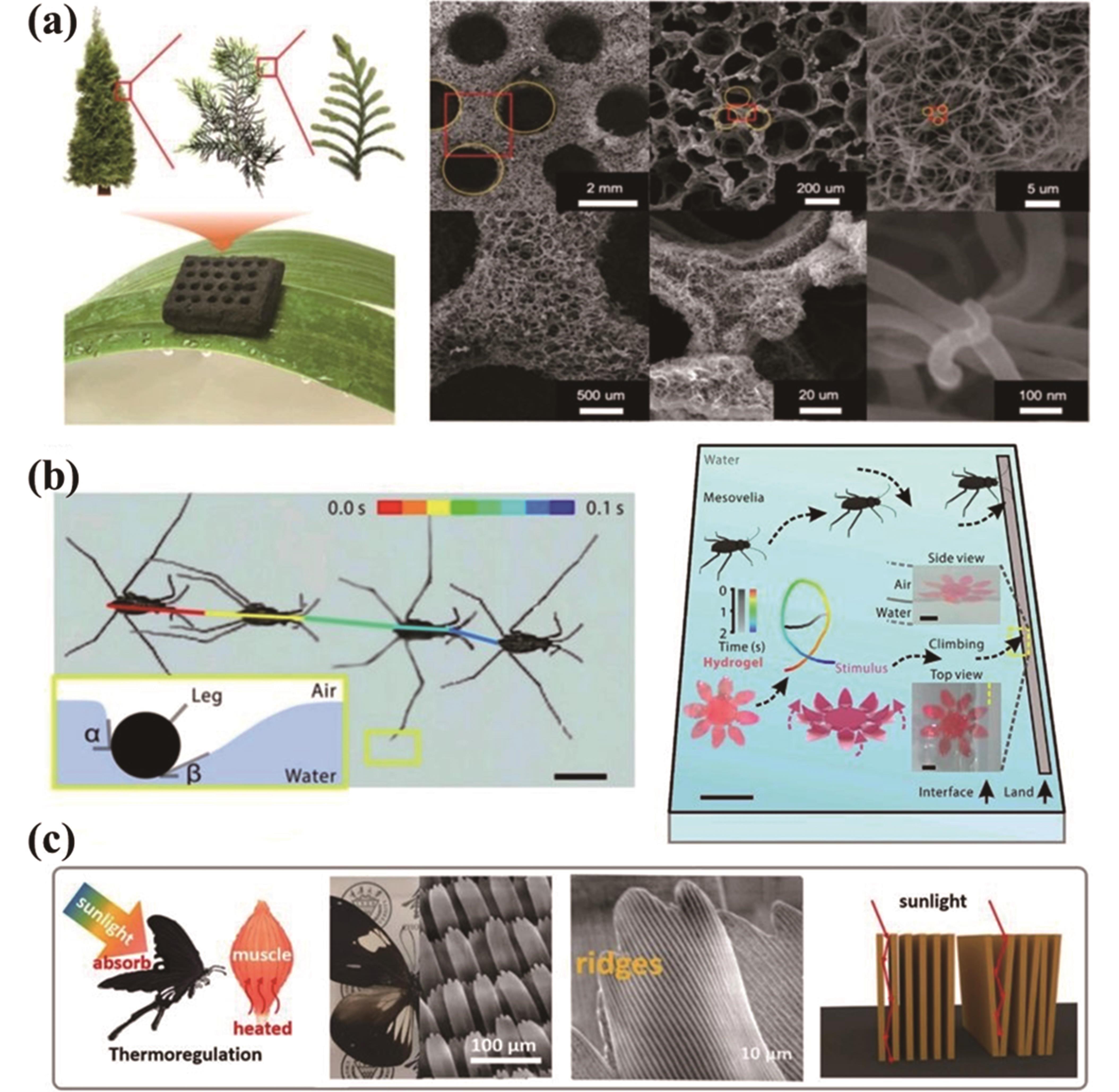
图2 与仿生相关的一些工作: (a)仿生分形结构助力海水淡化[26];(b)仿生水黾实现水凝胶自驱动水面运动[28];(c)仿生蝴蝶翅膀增强光吸收[30]
Fig.2 Some bio-inspired work: (a) Enhanced solar evaporation inspired by fractal structure[26]; (b) Self-propelled hydrogel inspired by water striders[28]; (c) Improvement mechanism of light adsorption inspired by butterfly wings[30]
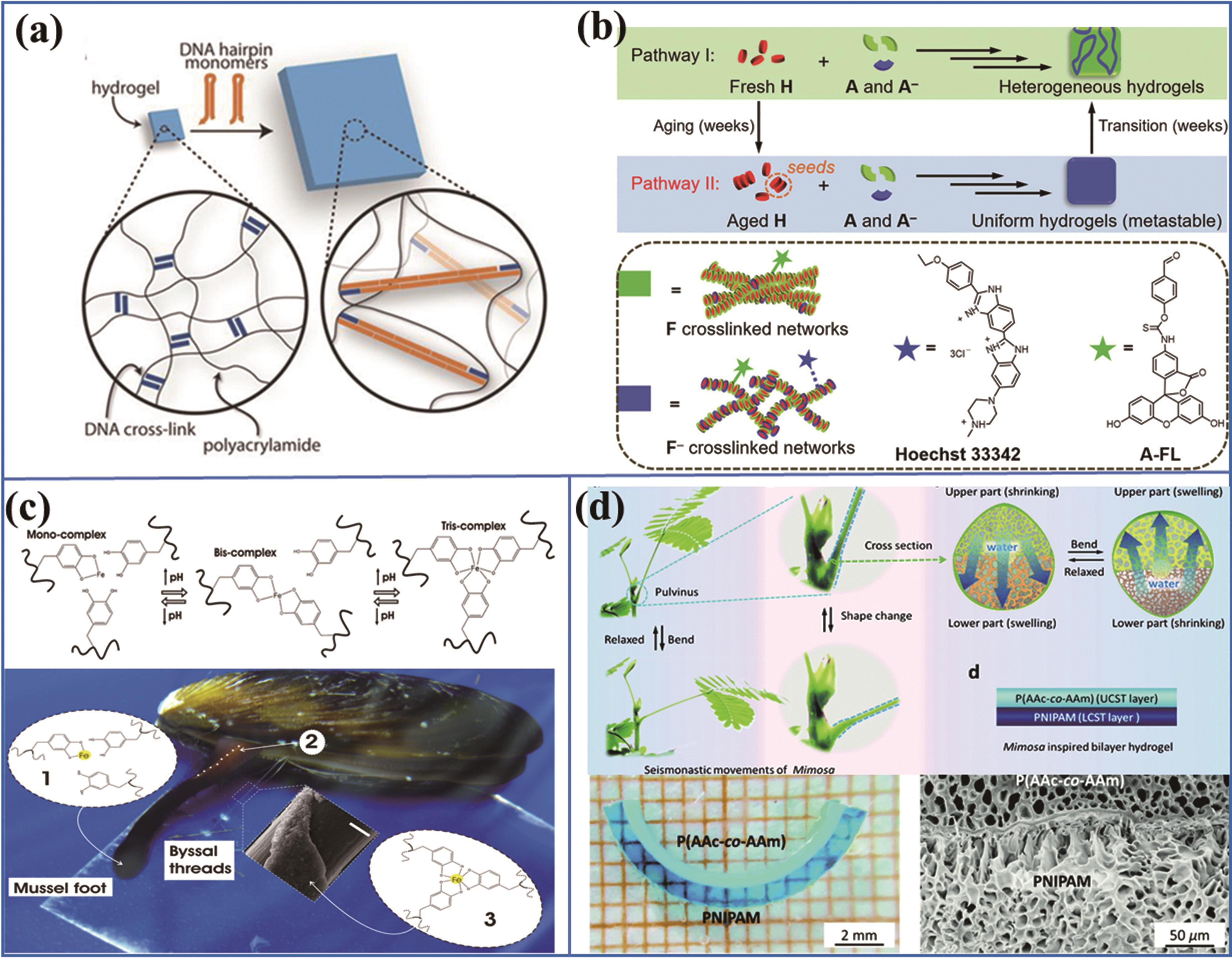
图4 水凝胶中涉及的仿生相关工作: (a)DNA用于水凝胶合成[57] ;(b)自组装现象用于水凝胶合成[63] ;(c)贻贝启发的功能性水凝胶[64] ;(d)含羞草启发的水凝胶驱动器[60]
Fig.4 Correlated work of bio-inspired hydrogels: (a) DNA sequence-directed shape change of hydrogels[57]; (b) Self-assembly phenomenon in synthesis of hydrogels[63]; (c) Mussel-inspired functional hydrogel[64]; (d) Mimosa-inspired hydrogel actuator[60]
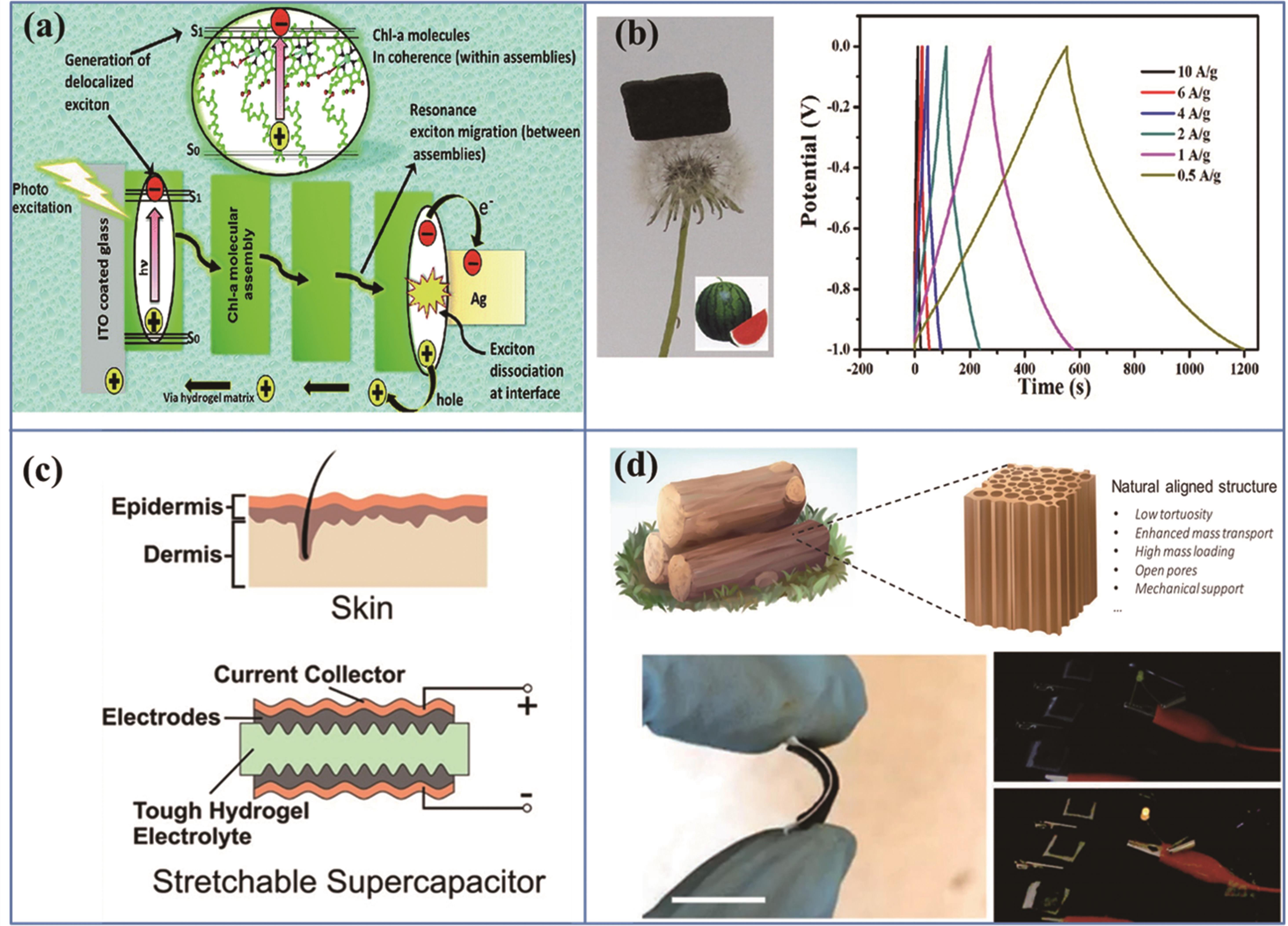
图5 仿生水凝胶在电池领域的应用: (a)叶绿素在太阳能电池中的应用[80];(b)碳化西瓜衍生水凝胶用作超级电容器[81];(c)仿生皮肤结构制备的水凝胶电解质[9];(d)木头启发的内部有序阵列电容器[82]
Fig.5 Applications of bio-inspired hydrogels in batteries: (a) A chlorophyll-a/polyacrylamide hydrogel for biomimetic solar cells[80]; (b) Biomass-derived hydrogel for supercapacitors[81]; (c) Skin-inspired tough hydrogel electrolyte[9]; (d) Wood-Inspired Morphologically Tunable Aligned Hydrogel for Supercapacitors[82]

图6 (a - b)仿生向日葵水凝胶的光催化性能[35]; (c)仿生海草水凝胶的光催化性能[91]; (d - f)仿生水凝胶的HER性能[92]
Fig.6 (a - b) H2O2 generation of the bionic sunflower[35]; (c) The photodegradation of seagrass-inspired hydrogel[91];(d - f) The HER performance of the bio-inspired hydrogel[92]
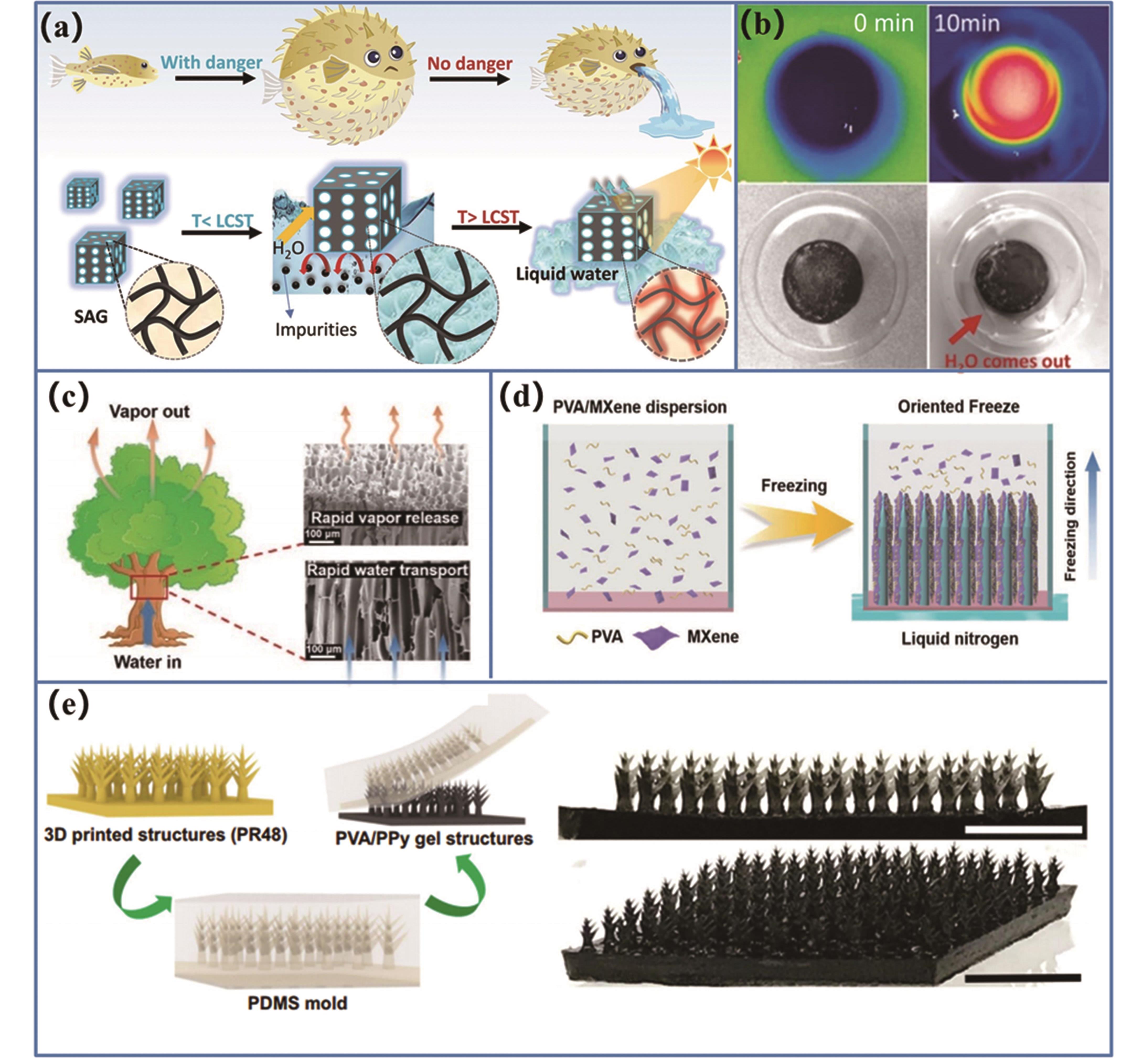
图7 界面蒸发、淡水收集相关设计:(a - b)仿河豚体积变化机制的净水水凝胶[99] ;(c - d)仿生树输水通道水凝胶的设计[100] ;(e)仿仙人掌锥刺结构水凝胶的合成[101]
Fig.7 Designs of bio-inspired for water collection and solar evaporation:(a - b)Pufferfish-inspired hydrogels for water purification[99]; (c - d)Tree-inspired hydrogels for solar evaporation [100];(e) The synthesis routine and morphology of the micro-tree hydrogel[101]

图8 (a,b)仿生树通道水凝胶的微观、宏观形貌[100] ;(c,d)仿生仙人掌锥刺结构水凝胶的微观和宏观形貌[101]
Fig.8 (a,b) The morphology of tree-inspired hydrogels[100]; (c,d) The morphology of cactus spine-inspired hydrogels[101]
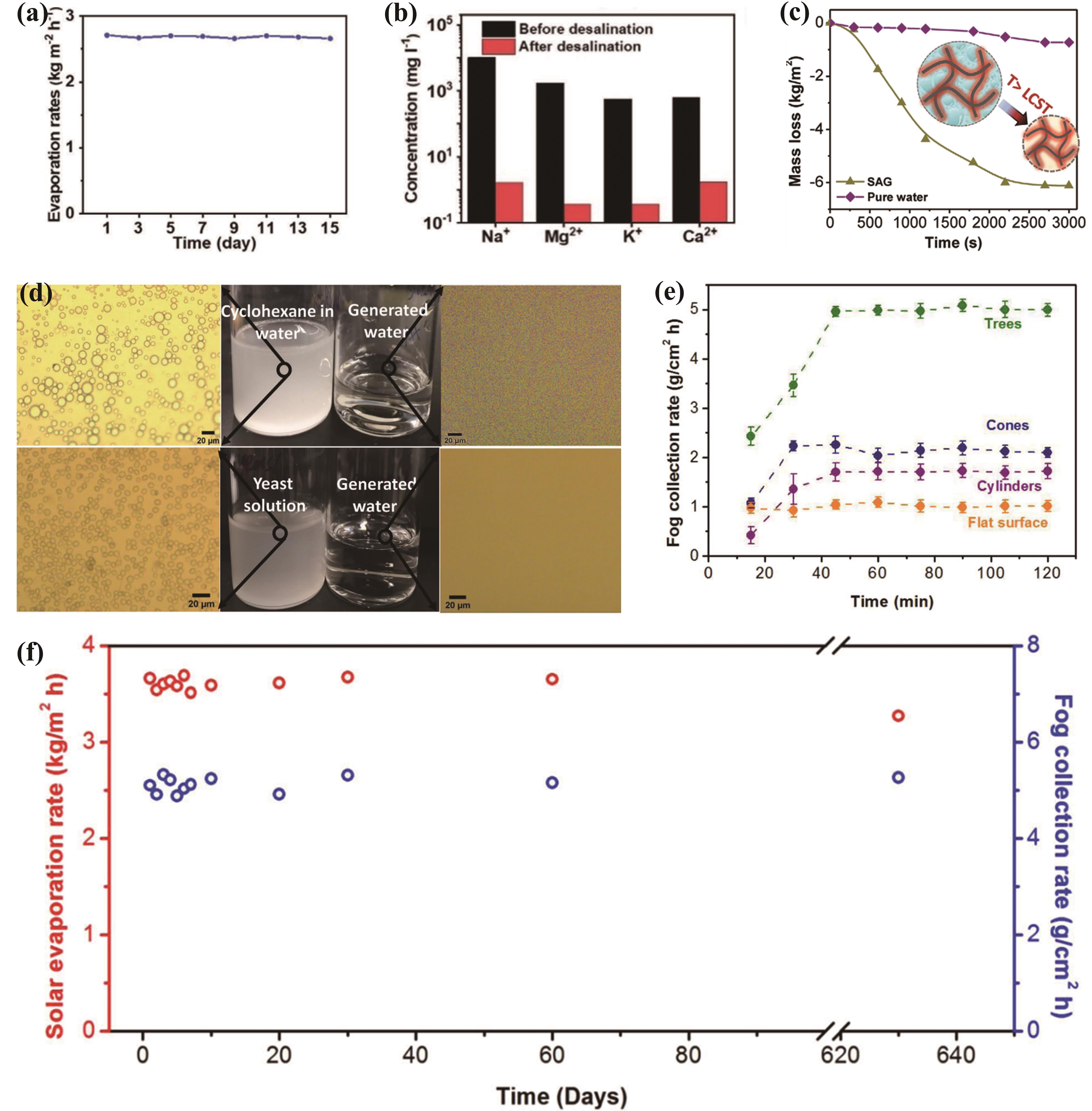
图9 (a,b)TIH蒸发性能及前后水质对比[100] ;(c,d)仿河豚水凝胶净水速率和前后水质对比[99];(e,f)仿仙人掌结构水凝胶的雾气收集性能和光热蒸发性能[101]
Fig.9 (a,b) The evaporation performance of TIH[100]; (c,d) The purification performance of the pufferfish-inspired hydrogels[99]; (e,f) The water collection performance of the micro-tree hydrogels[101]
| 1 | NI G, LI G, BORISKINA S V, et al. Steam generation under one sun enabled by a floating structure with thermal concentration[J]. Nat Energy, 2016, 1(9):16126. |
| 2 | ZHANG Q, UCHAKER E, CANDELARIA S L, et al. Nanomaterials for energy conversion and storage[J]. Chem Soc Rev, 2013, 42(7): 3127-3171. |
| 3 | DUNN B, KAMATH H, TARASCON J M. Electrical energy storage for the grid: a battery of choices[J]. Science, 2011, 334(6058): 928-935. |
| 4 | DING Y, ZHANG C, ZHANG L, et al. Molecular engineering of organic electroactive materials for redox flow batteries[J]. Chem Soc Rev, 2018, 47(1): 69-103. |
| 5 | DING Y, LI Y, YU G. Exploring bio-inspired Quinone-based organic redox flow batteries: a combined experimental and computational study[J]. Chem, 2016, 1(5): 790-801. |
| 6 | ZHANG L, ZHANG C, DING Y, et al. A low-cost and high-energy hybrid iron-aluminum liquid battery achieved by deep eutectic solvents[J]. Joule, 2017, 1(3): 623-633. |
| 7 | ZHAO Y, DING Y, LI Y, et al. A chemistry and material perspective on lithium redox flow batteries towards high-density electrical energy storage[J]. Chem Soc Rev, 2015, 44(22): 7968-7996. |
| 8 | DING Y, ZHAO Y, LI Y, et al. A high-performance all-metallocene-based, non-aqueous redox flow battery[J]. Energy Environ Sci, 2017, 10(2): 491-497. |
| 9 | FANG L, CAI Z, DING Z, et al. Skin-inspired surface-microstructured tough hydrogel electrolytes for stretchable supercapacitors[J]. ACS Appl Mater Interfaces, 2019, 11(24): 21895-21903. |
| 10 | ZHANG J, QU L, SHI G, et al. N,P-codoped carbon networks as efficient metal-free bifunctional catalysts for oxygen reduction and hydrogen evolution reactions[J]. Angew Chem Int Ed Engl, 2016, 55(6): 2230-2234. |
| 11 | ZHAO F, BAE J, ZHOU X, et al. Nanostructured functional hydrogels as an emerging platform for advanced energy technologies[J]. Adv Mater, 2018, 30(48): e1801796. |
| 12 | GUO Y, BAE J, ZHAO F, et al. Functional hydrogels for next-generation batteries and supercapacitors[J]. Trends Chem, 2019, 1(3): 335-348. |
| 13 | TAO P, NI G, SONG C, et al. Solar-driven interfacial evaporation[J]. Nat Energy, 2018, 3(12): 1031-1041. |
| 14 | GENG Y, ZHANG K, YANG K, et al. Constructing hierarchical carbon framework and quantifying water transfer for novel solar evaporation configuration[J]. Carbon, 2019, 155: 25-33. |
| 15 | GUO Y, YU G. Engineering hydrogels for efficient solar desalination and water purification[J]. Acc Mater Res, 2021, 2(5): 374-384. |
| 16 | ZENG X, QIAN L, YUAN X, et al. Inspired by stenocara beetles: from water collection to high-efficiency water-in-oil emulsion separation[J]. ACS Nano, 2017, 11(1): 760-769. |
| 17 | GUO Y, BAE J, FANG Z, et al. Hydrogels and hydrogel-derived materials for energy and water sustainability[J]. Chem Rev, 2020, 120(15): 7642-7707. |
| 18 | PEERS S, MONTEMBAULT A, LADAVIÈRE C. Chitosan hydrogels for sustained drug delivery[J]. J Control Release, 2020, 326: 150-63. |
| 19 | LI J, MOONEY D J. Designing hydrogels for controlled drug delivery[J]. Nat Rev Mater, 2016, 1(12): 16071. |
| 20 | ZAGÓRSKA-DZIOK M, SOBCZAK M. Hydrogel-based active substance release systems for cosmetology and dermatology application: a review[J]. Pharmaceutics, 2020, 12(5):396. |
| 21 | CHENG L, JI K, SHIH T Y, et al. Injectable shape-memorizing three-dimensional hyaluronic acid cryogels for skin sculpting and soft tissue reconstruction[J]. Tissue Eng Part A, 2016, 23(5/6): 243-251. |
| 22 | VIVERO-LOPEZ M, MURAS A, SILVA D, et al. Resveratrol-loaded hydrogel contact lenses with antioxidant and antibiofilm performance[J]. Pharmaceutics, 2021, 13(4). |
| 23 | YANG C, YIN J, CHEN Z, et al. Highly conductive, stretchable, adhesive, and self-healing polymer hydrogels for strain and pressure sensor[J]. Macromol Mater Eng, 2020, 305(12): 2000479. |
| 24 | SHI Y, ZHANG J, BRUCK A M, et al. A tunable 3D nanostructured conductive gel framework electrode for high-performance lithium ion batteries[J]. Adv Mater, 2017, 29(22): 1603922. |
| 25 | ZHOU X, ZHAO F, GUO Y, et al. Architecting highly hydratable polymer networks to tune the water state for solar water purification[J]. Sci Adv, 5(6): eaaw5484. |
| 26 | GENG Y, SUN W, YING P, et al. Bioinspired fractal design of waste biomass-derived solar-thermal materials for highly efficient solar evaporation[J]. Adv Funct Mater, 2020, 31(3):2007648. |
| 27 | GAO X, JIANG L. Water-repellent legs of water striders[J]. Nature, 2004, 432(7013): 36. |
| 28 | ZHU H, XU B, WANG Y, et al. Self-powered locomotion of a hydrogel water strider[J]. Sci Robot, 2021, 6(53): eabe7925. |
| 29 | SCHROEDER T B H, GUHA A, LAMOUREUX A, et al. An electric-eel-inspired soft power source from stacked hydrogels[J]. Nature, 2017, 552(7684): 214-218. |
| 30 | YING P, AI B, HU W, et al. A bio-inspired nanocomposite membrane with improved light-trapping and salt-rejecting performance for solar-driven interfacial evaporation applications[J]. Nano Energy, 2021, 89:106443. |
| 31 | LI Y, RODRIGUES J, TOMÁS H. Injectable and biodegradable hydrogels: gelation, biodegradation and biomedical applications[J]. Chem Soc Rev, 2012, 41(6): 2193-2221. |
| 32 | KO D Y, SHINDE U P, YEON B, et al. Recent progress of in situ formed gels for biomedical applications[J]. Prog Polym Sci , 2013, 38(3): 672-701. |
| 33 | WANG C, STEWART R J, KOPEČEK J. Hybrid hydrogels assembled from synthetic polymers and coiled-coil protein domains[J]. Nature, 1999, 397(6718): 417-420. |
| 34 | GUO B, HOSHINO Y, GAO F, et al. Thermocells driven by phase transition of hydrogel nanoparticles[J]. J Am Chem Soc , 2020, 142(41): 17318-17322. |
| 35 | QIN J, CHU K, HUANG Y, et al. The bionic sunflower: a bio-inspired autonomous light tracking photocatalytic system[J]. Energ Environ Sci , 2021, 14(7): 3931-3937. |
| 36 | JIANG B, LIU X, YANG C, et al. Injectable, photoresponsive hydrogels for delivering neuroprotective proteins enabled by metal-directed protein assembly[J]. Sci Adv, 6(41): eabc4824. |
| 37 | LIU T, WANG F, WU Q, et al. Fluorescent, electrically responsive and ultratough self-healing hydrogels via bioinspired all-in-one hierarchical micelles[J]. Mater Horiz, 2021, 8:3096. |
| 38 | PARDO A, GÓMEZ-FLORIT M, BARBOSA S, et al. Magnetic nanocomposite hydrogels for tissue engineering: design concepts and remote actuation strategies to control cell fate[J]. ACS Nano, 2021, 15(1): 175-209. |
| 39 | ZHANG Y, WU F, LI M, et al. pH switching on-off semi-IPN hydrogel based on cross-linked poly(acrylamide-co-acrylic acid) and linear polyallyamine[J]. Polymer, 2005, 46(18): 7695-7700. |
| 40 | GUO W, LU C H, ORBACH R, et al. pH-stimulated DNA hydrogels exhibiting shape-memory properties[J]. Adv Mater, 2015, 27(1): 73-78. |
| 41 | GALPERIN A, LONG T J, RATNER B D. Degradable, thermo-sensitive poly(N-isopropyl acrylamide)-based scaffolds with controlled porosity for tissue engineering applications[J]. Biomacromolecules, 2010, 11(10): 2583-2592. |
| 42 | OKANO T, BAE Y H, JACOBS H, et al. Thermally on-off witching polymers for drug permeation and release[J]. J Control Release, 1990, 11: 255-265. |
| 43 | DUAN J, YU B, LIU K, et al. P-N conversion in thermogalvanic cells induced by thermo-sensitive nanogels for body heat harvesting[J]. Nano Energy, 2019, 57: 473-479. |
| 44 | YOKOYAMA F, ACHIFE E, MOMODA J, et al. Morphology of optically anisotropic agarose hydrogel prepared by directional freezing[J]. Colloid Polym Sci, 1990, 268: 552-558. |
| 45 | GONG J P. Why are double network hydrogels so tough?[J]. Soft Matter, 2010, 6(12): 2583-2590. |
| 46 | GONG J P, KATSUYAMA Y, KUROKAWA T, et al. Double-network hydrogels with extremely high mechanical strength[J]. Adv Mater, 2003, 15(14): 1155-1158. |
| 47 | MACAN J. Definitions of terms relating to the structure and processing of sols, gels, networks, and inorganic-organic hybrid materials[J]. Kemija U Industriji, 2011, 60(3): 135-153. |
| 48 | ZHANG Y S, KHADEMHOSSEINI A. Advances in engineering hydrogels[J]. Science, 2017, 356(6337):eaaf3627. |
| 49 | AHMED E M. Hydrogel: preparation, characterization, and applications: a review[J]. J Adv Res, 2015, 6(2): 105-121. |
| 50 | SILVERSTEIN T. The real reason why oil and water don't mix[J]. J Chem Educ, 1998, 75(1):116. |
| 51 | HASELMEIER R, HOLZ M, MARBACH W, et al. Water dynamics near a dissolved noble gas. first direct experimental evidence for a retardation effect[J]. J Phys Chem, 1995, 99(8): 2243-2246. |
| 52 | GACESA P. Alginates[J]. Carbonhydr Polym, 1988, 8(3): 161-182. |
| 53 | NELE V, WOJCIECHOWSKI J P, ARMSTRONG J P K, et al. Tailoring gelation mechanisms for advanced hydrogel applications[J]. Adv Funct Mater, 2020, 30(42): 2002759. |
| 54 | HENNINK W E, VAN NOSTRUM C F. Novel crosslinking methods to design hydrogels[J]. Adv Drug Deliver Rev, 2012, 64(1): 223-236. |
| 55 | VARAPRASAD K, RAGHAVENDRA G M, JAYARAMUDU T, et al. A mini review on hydrogels classification and recent developments in miscellaneous applications[J]. Mater Sci Eng C, 2017, 79: 958-971. |
| 56 | GAO H, ZHOU W, JANG J H, et al. Cross-linked chitosan as a polymer network binder for an antimony anode in sodium-ion batteries[J]. Adv Energy Mater, 2016, 6(6): 1502130. |
| 57 | CANGIALOSI A, YOON C, LIU J, et al. DNA sequence-directed shape change of photopatterned hydrogels via high-degree swelling[J]. Science, 2017, 357(6356): 1126-1130. |
| 58 | FAN H, GONG J P. Fabrication of bioinspired hydrogels: challenges and opportunities[J]. Macromolecules, 2020, 53(8): 2769-2782. |
| 59 | WANG J, LIN L, CHENG Q, et al. A strong bio-inspired layered PNIPAM-clay nanocomposite hydrogel[J]. Angew Chem Int Ed, 2012, 51(19): 4676-4680. |
| 60 | ZHENG J, XIAO P, LE X, et al. Mimosa inspired bilayer hydrogel actuator functioning in multi-environments[J]. J Mater Chem C, 2018, 6(6): 1320-1327. |
| 61 | WANG Y, DE KRUIJFF R M, LOVRAK M, et al. Access to metastable gel states using seeded self-assembly of low-molecular-weight gelators[J]. Angew Chem Int Ed, 2019, 58(12): 3800-3803. |
| 62 | WANG Y, LOVRAK M, LIU Q, et al. Hierarchically compartmentalized supramolecular gels through multilevel self-sorting[J]. J Am Chem Soc, 2019, 141(7): 2847-2851. |
| 63 | WANG Y, PISKORZ T K, LOVRAK M, et al. Transient supramolecular hydrogels formed by aging-induced seeded self-assembly of molecular hydrogelators[J]. Adv Sci, 2020, 7(7): 1902487. |
| 64 | HOLTEN-ANDERSEN N, HARRINGTON M J, BIRKEDAL H, et al. pH-induced metal-ligand cross-links inspired by mussel yield self-healing polymer networks with near-covalent elastic moduli[J]. Proc Natl Acad Sci USA, 2011, 108(7): 2651-2655. |
| 65 | SHI Y, PENG L, YU G. Nanostructured conducting polymer hydrogels for energy storage applications[J]. Nanoscale, 2015, 7(30): 12796-12806. |
| 66 | YANO H, KUDO K, MARUMO K, et al. Fully soluble self-doped poly(3,4-ethylenedioxythiophene) with an electrical conductivity greater than 1000 S cm-1[J]. Sci Adv, 2019,5(4): eaav9492. |
| 67 | FORD H O, PARK B, JIANG J, et al. Enhanced Li+ conduction within single-ion conducting polymer gel electrolytes via reduced cation-polymer interaction[J]. ACS Mater Lett, 2020, 2(3): 272-279. |
| 68 | CACCAVO D, CASCONE S, LAMBERTI G, et al. Hydrogels: experimental characterization and mathematical modelling of their mechanical and diffusive behaviour[J]. Chem Soc Rev, 2018, 47(7): 2357-2373. |
| 69 | CHOI D, WANG D, BAE I T, et al. LiMnPO4 nanoplate grown via solid-state reaction in molten hydrocarbon for Li-ion battery cathode[J]. Nano Lett, 2010, 10(8): 2799-2805. |
| 70 | ZHAO F, SHI Y, PAN L, et al. Multifunctional nanostructured conductive polymer gels: synthesis, properties, and applications[J]. Acc Chem Res, 2017, 50(7): 1734-1743. |
| 71 | HASEGAWA G, ISHIHARA Y, KANAMORI K, et al. Facile preparation of monolithic LiFePO4/carbon composites with well-defined macropores for a lithium-ion battery[J]. Chem Mater, 2011, 23. |
| 72 | ZHANG P, WANG K, PEI P, et al. Selection of hydrogel electrolytes for flexible zinc-air batteries[J]. Mater Today Chem, 2021, 21: 100538. |
| 73 | ZHAO S, ZUO Y, LIU T, et al. Multi-functional hydrogels for flexible zinc-based batteries working under extreme conditions[J]. Adv Energy Mater, 2021, 11(34): 2101749. |
| 74 | LIZUNDIA E, KUNDU D. Advances in natural biopolymer-based electrolytes and separators for battery applications[J]. Adv Funct Mater, 2021, 31(3): 2005646. |
| 75 | ALLAN P K, GRIFFIN J M, DARWICHE A, et al. Tracking sodium-antimonide phase transformations in sodium-ion anodes: insights from operando pair distribution function analysis and solid-state NMR spectroscopy[J]. J Am Chem Soc, 2016, 138(7): 2352-2365. |
| 76 | WU P, ZHANG A, PENG L, et al. Cyanogel-enabled homogeneous Sb-Ni-C ternary framework electrodes for enhanced sodium storage[J]. ACS Nano, 2018, 12(1): 759-767. |
| 77 | QIN G, WANG M, FAN L, et al. Multifunctional supramolecular gel polymer electrolyte for self-healable and cold-resistant supercapacitor[J]. J Power Sources, 2020, 474: 228602. |
| 78 | KOO B, KIM H, CHO Y, et al. A highly cross-linked polymeric binder for high-performance silicon negative electrodes in lithium ion batteries[J]. Angew Chem Int Ed, 2012, 51(35): 8762-8767. |
| 79 | LIU J, ZHANG Q, WU Z Y, et al. A high-performance alginate hydrogel binder for the Si/C anode of a Li-ion battery[J]. Chem Commun, 2014, 50(48): 6386-6389. |
| 80 | MANDAL P, MANNA J S, DAS D, et al. Energy transfer cascade in bio-inspired chlorophyll-a/polyacrylamide hydrogel: towards a new class of biomimetic solar cells[J]. RSC Adv, 2016, 6(93): 90280-90289. |
| 81 | WU X L, WEN T, GUO H L, et al. Biomass-derived sponge-like carbonaceous hydrogels and aerogels for supercapacitors[J]. ACS Nano, 2013, 7(4): 3589-3597. |
| 82 | ZHAO Y, ALSAID Y, YAO B, et al. Wood-Inspired morphologically tunable aligned hydrogel for high-performance flexible all-solid-state supercapacitors[J]. Adv Funct Mater, 2020, 30(10): 1909133. |
| 83 | WANG B, LI J, HOU C, et al. Stable hydrogel electrolytes for flexible and submarine-use Zn-ion batteries[J]. ACS Appl Mater Interfaces, 2020, 12(41): 46005-46014. |
| 84 | RYU J, KIM S W, KANG K, et al. Mineralization of self-assembled peptide nanofibers for rechargeable lithium ion batteries[J]. Adv Mater, 2010, 22(48): 5537-5541. |
| 85 | TIAN M, CHEN X, SUN S, et al. A bioinspired high-modulus mineral hydrogel binder for improving the cycling stability of microsized silicon particle-based lithium-ion battery[J]. Nano Res, 2019, 12(5): 1121-1127. |
| 86 | FU G, YAN X, CHEN Y, et al. Boosting bifunctional oxygen electrocatalysis with 3D graphene aerogel-supported Ni/MnO particles[J]. Adv Mater, 2018, 30(5): 1704609. |
| 87 | JIANG H, ZHU Y, FENG Q, et al. Nitrogen and phosphorus dual-doped hierarchical porous carbon foams as efficient metal-free electrocatalysts for oxygen reduction reactions[J]. Chem Eur J, 2014, 20(11): 3106-3112. |
| 88 | HU Q, LI G, LIU X, et al. Superhydrophilic phytic-acid-doped conductive hydrogels as metal-free and binder-free electrocatalysts for efficient water oxidation[J]. Angew Chem Int Ed, 2019, 58(13): 4318-4322. |
| 89 | GUO X, CAO G L, DING F, et al. A bulky and flexible electrocatalyst for efficient hydrogen evolution based on the growth of MoS2 nanoparticles on carbon nanofiber foam[J]. J Mater Chem A, 2015, 3(9): 5041-5046. |
| 90 | MA C, XIE Z, SEO W C, et al. Carbon dot-coupled BiVO4/reduced graphene hydrogel for significant enhancement of photocatalytic activity: antibiotic degradation and CO2 reduction[J]. Appl Surf Sci, 2021, 565: 150564. |
| 91 | YONG Z, YAP L W, FU R, et al. Seagrass-inspired design of soft photocatalytic sheets based on hydrogel-integrated free-standing 2D nanoassemblies of multifunctional nanohexagons[J]. Mater Horiz, 2021, 8(9): 2533-2540. |
| 92 | SHI Y, DAI W, WANG M, et al. Bioinspired construction of ruthenium-decorated nitrogen-doped graphene aerogel as an efficient electrocatalyst for hydrogen evolution reaction[J]. Chem Res Chinese Univ, 2020, 36(4): 709-714. |
| 93 | WEINGARTEN A S, KAZANTSEV R V, PALMER L C, et al. Self-assembling hydrogel scaffolds for photocatalytic hydrogen production[J]. Nat Chem, 2014, 6(11): 964-970. |
| 94 | YING P, LI M, YU F, et al. Band gap engineering in an efficient solar-driven interfacial evaporation system[J]. ACS Appl Mater Interfaces, 2020, 12(29): 32880-32887. |
| 95 | ZHANG H, WANG Y, LIU Y, et al. Efficient solar evaporation by [Ni(Phen)3][V14O34Cl]Cl hybrid semiconductor confined in mesoporous glass[J]. ChemSusChem, 2020, 13(11): 2945-2951. |
| 96 | CHEN J, YE Z, YANG F, et al. Plasmonic nanostructures for photothermal conversion[J]. Small Sci, 2021, 1(2): 2000055. |
| 97 | SHI Y, MA C, PENG L, et al. Conductive “smart” hybrid hydrogels with PNIPAM and nanostructured conductive polymers[J]. Adv Funct Mater, 2015, 25(8): 1219-1225. |
| 98 | ZHAO F, ZHOU X, SHI Y, et al. Highly efficient solar vapour generation via hierarchically nanostructured gels[J]. Nat Nanotechnol, 2018, 13(6): 489-495. |
| 99 | XU X, OZDEN S, BIZMARK N, et al. A bioinspired elastic hydrogel for solar-driven water purification[J]. Adv Mater, 2021, 33(18): 2007833. |
| 100 | YU Z, WU P. Biomimetic MXene-polyvinyl alcohol composite hydrogel with vertically aligned channels for highly efficient solar steam generation[J]. Adv Mater Technol, 2020, 5(6): 2000065. |
| 101 | SHI Y, ILIC O, ATWATER H A, et al. All-day fresh water harvesting by microstructured hydrogel membranes[J]. Nat Commun, 2021, 12(1): 2797. |
| 102 | LU Y, FAN D, WANG Y, et al. Surface patterning of two-dimensional nanostructure-embedded photothermal hydrogels for high-yield solar steam generation[J]. ACS Nano, 2021, 15(6): 10366-10376. |
| 103 | SEKINE Y, IKEDA-FUKAZAWA T. Structural changes of water in a hydrogel during dehydration[J]. J Chem Phys, 2009, 130(3): 034501. |
| 104 | KUDO K, ISHIDA J, SYUU G, et al. Structural changes of water in poly(vinyl alcohol) hydrogel during dehydration[J]. J Chem Phys, 2014, 140(4): 044909. |
| 105 | ZHAO F, GUO Y, ZHOU X, et al. Materials for solar-powered water evaporation[J]. Nat Rev Mater, 2020, 5(5): 388-401. |
| 106 | GUO Y, ZHOU X, ZHAO F, et al. Synergistic energy nanoconfinement and water activation in hydrogels for efficient solar water desalination[J]. ACS Nano, 2019, 13(7): 7913-7919. |
| 107 | ZHAO F, ZHOU X, LIU Y, et al. Super moisture-absorbent gels for all-weather atmospheric water harvesting[J]. Adv Mater, 2019, 31(10): 1806446. |
| 108 | LI R, SHI Y, ALSAEDI M, et al. Hybrid hydrogel with high water vapor harvesting capacity for deployable solar-driven atmospheric water generator[J]. Environ Sci Technol 2018, 52(19): 11367-11377. |
| 109 | NANDAKUMAR D K, ZHANG Y, RAVI S K, et al. Solar energy triggered clean water harvesting from humid air existing above sea surface enabled by a hydrogel with ultrahigh hygroscopicity[J]. Adv Mater, 2019, 31(10): 1806730. |
| 110 | ENTEZARI A, EJEIAN M, WANG R. Super atmospheric water harvesting hydrogel with alginate chains modified with binary salts[J]. ACS Mater Lett, 2020, 2(5): 471-477. |
| 111 | KALLENBERGER P A, FRÖBA M. Water harvesting from air with a hygroscopic salt in a hydrogel-derived matrix[J]. Commun Chem, 2018, 1(1): 28. |
| 112 | WANG M, SUN T, WAN D, et al. Solar-powered nanostructured biopolymer hygroscopic aerogels for atmospheric water harvesting[J]. Nano Energy, 2021, 80: 105569. |
| 113 | CHEN X, WU Z, LAI D, et al. Resilient biomass-derived hydrogel with tailored topography for highly efficient and long-term solar evaporation of high-salinity brine[J]. J Mater Chem A, 2020, 8(43): 22645-22656. |
| [1] | 黄旭娟, 王婷, 丁正青, 杨欣欣, 蔡照胜, 商士斌. 脱氢枞氧基聚氧乙烯缩水甘油醚接枝羟乙基壳聚糖水凝胶制备及其性能[J]. 应用化学, 2022, 39(9): 1421-1428. |
| [2] | 袁定坤, 褚维凡, 倪加惠. 亚铁氰化铜-聚丙烯酰胺/羧甲基纤维素/石墨烯复合水凝胶的制备及铷吸附性能[J]. 应用化学, 2022, 39(11): 1746-1756. |
| [3] | 赵常利, 秦明高, 窦晓秋, 冯传良. 纳米颗粒增强的手性超分子水凝胶成骨性能[J]. 应用化学, 2022, 39(1): 177-187. |
| [4] | 张晋红, 石奎, 徐鹏, 李倩, 薛龙建. 仿生表面液固界面摩擦力的动态调控[J]. 应用化学, 2022, 39(1): 188-195. |
| [5] | 李胜男, 付俊. 水凝胶仿生柔性电子学[J]. 应用化学, 2022, 39(1): 55-73. |
| [6] | 唐立宗, 张琳, 董云生, 齐春晓, 刘祥胜, 王淑芳. 响应性水凝胶及其在生物医药领域应用研究进展[J]. 应用化学, 2021, 38(7): 743-753. |
| [7] | 周超, 生程钜, 闻林林. 咪唑盐类聚离子液体抗菌剂的制备及其在水凝胶敷料中的应用[J]. 应用化学, 2021, 38(1): 51-59. |
| [8] | 佘小红, 杜娟, 王璐珮, 朱雯莉, 杨巧玲, 邹智挥. 高强度聚乙烯醇/聚苯胺/聚吡咯/TiO2导电杂化水凝胶的制备与性能[J]. 应用化学, 2020, 37(5): 541-546. |
| [9] | 郭晓艳, 程晓琪, 张良良, 黄毅萍, 许戈文, 鲍俊杰. N,N-双(2-羟乙基)-2-氨基乙磺酸钠为扩链剂的磺酸型聚氨酯水凝胶制备及性能[J]. 应用化学, 2019, 36(6): 631-640. |
| [10] | 陈昆峰,薛冬峰. 离子的胶体状态与其电化学储能极限[J]. 应用化学, 2018, 35(9): 1067-1075. |
| [11] | 黄刚, 张宏伟, 张欢欢, 石彤非, 许东华. 氧化石墨烯对聚乙烯醇/硼酸水凝胶流变性能的影响[J]. 应用化学, 2018, 35(7): 767-775. |
| [12] | 梁学称,邓裕坤,裴小朋,翟侃侃,徐昆,谭颖,王丕新. 非冻结水对微球复合水凝胶机械性能的影响[J]. 应用化学, 2018, 35(11): 1301-1308. |
| [13] | 段元首, 贾凤霞, 王朔, 李丽芳. 聚N-异丙基丙烯酰胺/类水滑石复合水凝胶的制备及温敏性[J]. 应用化学, 2018, 35(1): 102-108. |
| [14] | 赵立平, 蔡兴楠, 王宏宇, 齐力. 三氧化钼—一种新型有机系钠离子储能器件负极材料[J]. 应用化学, 2017, 34(3): 262-268. |
| [15] | 赵立平, 蔡兴楠, 王宏宇, 齐力. 三氧化钼—一种新型有机系钠离子储能器件负极材料[J]. 应用化学, 2017, 34(3): 0-0. |
| 阅读次数 | ||||||
|
全文 |
|
|||||
|
摘要 |
|
|||||
